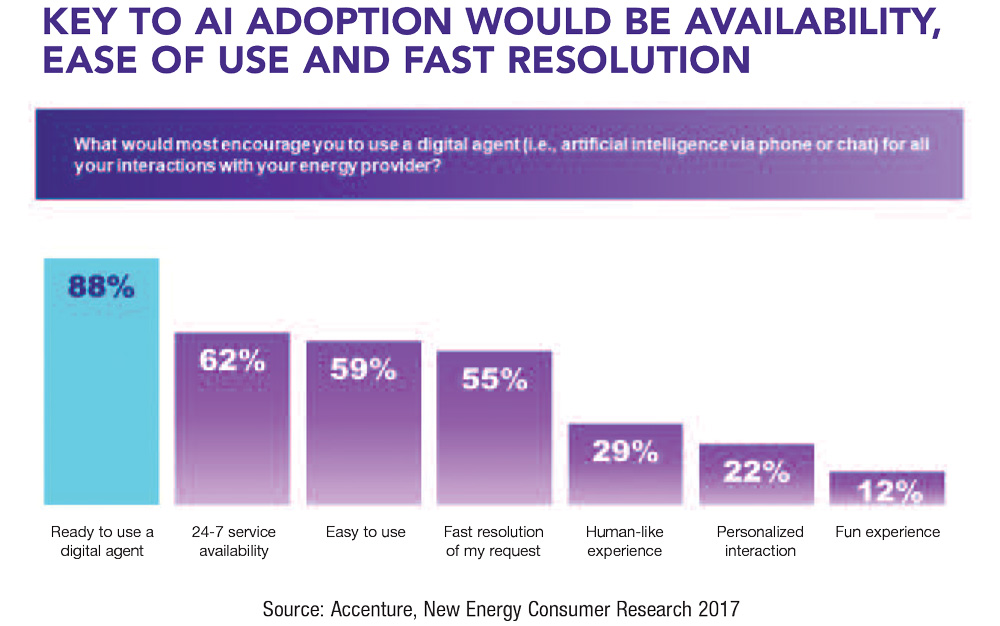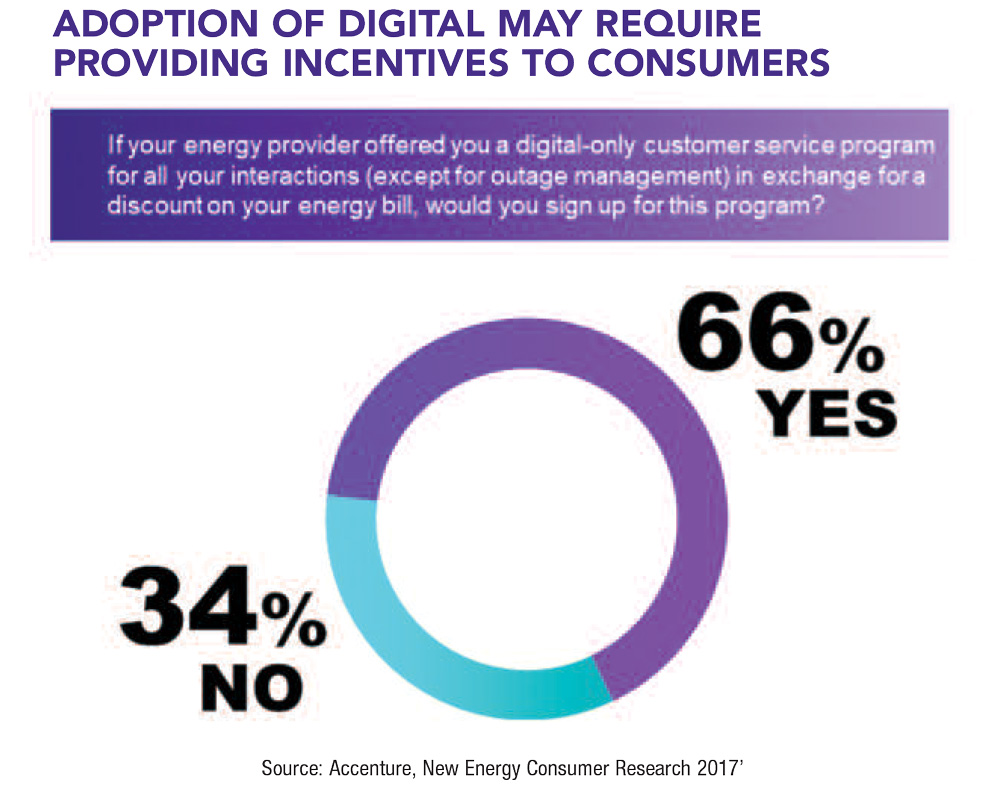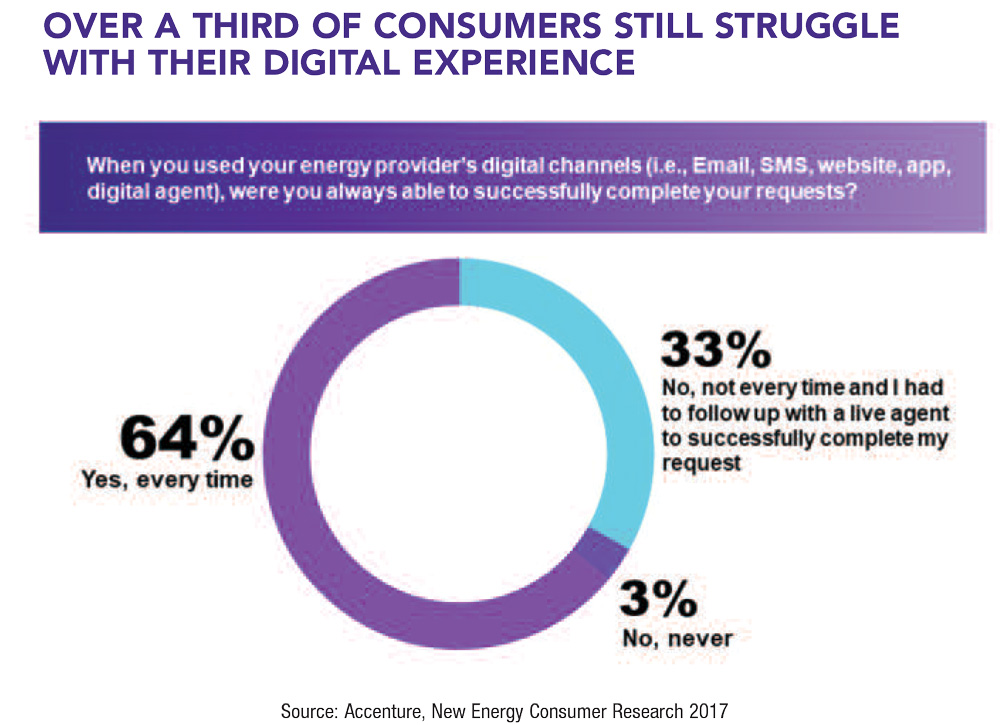How utility providers can create new value using artificial intelligence


Under the combined pressure of meeting both consumer expectations and regulatory requirements, utility providers should evolve and embark upon an AI journey in order to improve digital interactions and customer experience. Hilary O’Meara, Head of Resources, Accenture Ireland writes.
Utility providers are being squeezed by falling profits, technology disruption and outside competitors targeting their customers, and now they face the additional challenge of needing to do more to deliver on consumers’ expectations for digital channels and personalised experiences, according to Accenture Ireland’s annual New Energy Consumer research. What’s more, customers are calling out for a tailored, fun and 24/7 service, and believe that artificial intelligence is a way to
achieve this.
Consumer demand
The survey of 500 Irish energy consumers found that one-third (33 per cent) say their provider’s digital channels (websites and mobile applications) could not meet their online requests and they had to contact a live agent. What’s more, over a quarter say they’re not aware of any digital channels being on offer from their provider (28 per cent). That being said; if it was on offer, the majority of those surveyed would be willing to go digital-only and switch to a wholly online service in exchange for a discount on their bill (66 per cent).
Ready for AI
The research also shows that artificial intelligence is one area that could pique consumer interest in digital. A significant nine in 10 (88 per cent) Irish customers confirmed that they are ready to engage with a ‘digital agent’ (i.e. a computer programme that simulates human conversation using artificial intelligence via phone or chat) to manage their energy usage and payment. Irish consumers expressed a significant interest in communicating via AI when it comes to learning about new products (76 per cent), making payments (72 per cent), asking questions about their bill (59 per cent) and making complaints (55 per cent). Key to AI adoption amongst Irish consumers would be 24/7 availability (62 per cent), ease of use (59 per cent), and fast resolution (55 per cent). Over one in 10 (12 per cent) would be more likely to use a digital agent if it was a fun experience.
Moving to multi-speed
Utility providers are under more pressure than ever to rotate toward new, integrated end-consumer solutions and rapidly launch new products and digital services. They are required to shift from traditional long planning cycles and rigid processes to create a new approach that responds quickly to call-outs from customers, who are increasingly using digital channels, services, and platforms – before their more agile, digital-native competitors beat them to it.
Providers must enable a customer operating model that puts people and customers at the heart of product and experience design. More digital engagement is necessary for utility providers to grow new revenue streams, build customer loyalty and in deregulated markets position against price-only plays. Artificial intelligence is one pertinent example of this and the willingness amongst Irish customers to use digital agents demonstrates how the rules of engagement are changing.
With this quest to keep pace with consumers’ ‘instant everything’ expectations, artificial intelligence is poised to change the customer service paradigm.
The research shows that energy consumers’ expectations have become liquid – flowing like water across the experiences they have with all their providers in multiple industries. They want their needs met and their questions answered instantly, preferably while simultaneously doing other tasks. For their part, utility providers appreciate speed too. They want to drive efficiency and accuracy at a lower cost – without impacting customer experience. Traditionally, consumers’ and providers’ goals have been at odds. That’s now changing thanks to the latest developments in digital technologies, including digital agents, powered by AI.
Defining AI
Artificial intelligence is a loosely applied term that covers a broad range of technologies at varying levels of maturity, from chatbots to virtual/digital assistants. Chatbots are at the lower end of the scale – chatbots follow a script and provide responses to specific enquiries, carrying out many of the functions of a mobile app or website. They are highly cost effective and can be deployed quickly across multiple platforms and interactions.
The findings above, however, highlight that consumers want to engage by voice, and that means doing so in their own language through natural language processing with the support of additional intelligence from algorithms, machine learning or deep learning. A consumer asking why his or her bill is so high, for instance, might trigger a process in billing enquiry and the release of some data about the consumer’s energy profile versus actual consumption, possibly accompanied by a recommendation for how to reduce energy consumption or change the terms of the contract.


Let’s get digital
Recognising a voice or a visual image brings us into the realm of AI. Digital assistants employing AI are fuelled by analytics but are also able to learn and train themselves. They can recognise not just faces and voices but also human emotions and facial expressions.
A utility provider faced with a high volume of repetitive enquiries requiring simple manual intervention may decide to automate these steps, by adding robotisation. The benefits to utility providers of introducing digital agents can be significant, including cost saving, revenue generation and improved customer satisfaction.
Delivering value for utility providers
Utility providers’ interest in digital agents is also high. In Accenture’s 2017 Technology Vision survey of utility executives, 37 per cent of respondents indicated they will be investing extensively in embedded AI-related technologies over the next three years. Likewise, leading utility providers have begun to integrate digital agents into their service offerings.
For example, the UK’s EDF Energy, serving approximately 5 million business and residential consumers with electricity or gas, uses Amazon’s Alexa as a service channel, helping consumers in areas such as account balance enquiries, learning next payment dates and submitting meter readings.
When consumers install the EDF Energy ‘Skill’ on their Alexa-enabled device, they can manage their energy accounts by using just their voice. The solution delivers an easy, fast interface that is available 24/7, meeting all three of consumers’ top adoption factors.
Irish utility providers must also address major industry programmes and regulatory requirements including the Integrated Single Electricity Market (I-SEM), National Smart Metering Programme and GDPR as a few examples. These transformational changes introduce sizable challenges for utility providers and their existing workforce with higher volumes of data flows, customer interactions and compliance activities. Digital agents can be a powerful supporting ally to managing such change, allowing a utility provider’s workforce to focus on the value drivers that these programmes bring.
Digital agents present utility providers with an opportunity to forge digital connections with their customers and, in the process, open doors to potential new revenue sources. As digital agents become more sophisticated and easier to use, they will lend themselves to more complex transactions and create new ways for utility providers to lower costs, increase loyalty and generate new revenues.

Launching the AI journey
In Accenture’s experience, utility providers exploring digital options should:
1. Gather knowledge. Providers should familiarise themselves with how digital agents – ranging from simple chatbots to highly sophisticated digital concierges – are being used today, not just in the utility industry but in other sectors such as online retailing. It is important to know not just what is happening now but what is likely to happen tomorrow, such as digital agents with self-learning capabilities that leverage customer data to offer tailored services or make personalised suggestions in real time.
2. Provide personality. Experience from early adopters has shown that giving a digital agent a personality is critical. Personality, tone of voice and the styling of the interface are all elements that require thinking and testing with the target audience.
3. Run pilots. To create interactions that are as efficient and painless as possible, run pilots alongside experienced human agents so that they can train the digital agents, handle more complicated scenarios and fine-tune before large-scale implementation.
4. Determine best applications. Digital agents should be positioned as a leading tool within the overall customer experience. A service design process helps in understanding the customer experience across different channels and in identifying high-potential areas for the use of digital agents.
5. Ensure seamlessness. Confirming that simple interactions and tasks are completed seamlessly is critical. The digital agent should be integrated smoothly into the application landscape and into mobile and web services.
The need for personalisation
For Irish consumers who had interacted with their energy providers via digital channels over the past 12 months, digital dissatisfaction stemmed from issues like having trouble finding information on energy providers’ websites (40 per cent). Consumers also said these sites took too long to load (37 per cent); lacked needed information (31 per cent) and were not fun or interesting to use (30 per cent). Personalisation is also an issue, with 29 per cent maintaining that the web channels weren’t tailored to their experience and 27 per cent claiming the sites didn’t have the information or features they needed. Linked to this, products that are tailored to individual needs and preferences were identified as the top incentive that would encourage Irish customers to sign up for more services (81 per cent).
Most consumers think that traditional utility providers are best positioned overall to help them manage their energy usage. However, the boundaries are blurring and the research indicates that alternative providers, such as home appliance manufacturers and general technology companies, are now seen by more than 60 per cent of Irish customers as well positioned to help them understand and manage their energy consumption.
In essence, automation is moving fast and can, we believe, have a major impact on how utility providers connect with their customers. Providers that act now to integrate digital agents into the customer experience can address rising customer expectations while creating a foundation for future service offerings.
For more information:
T: 01 646 2201
E: hilary.omeara@accenture.com
W: www.accenture.com/ie-en/new-applied-now





